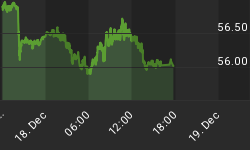Death by a thousand cuts. At least that is what it felt like for those poor souls who were invested in precious metals during the 1980s and 1990s. By the time the bear market in gold and silver had ended in 2000-01, the asset class had become abandoned by mainstream investors. Gold and silver bulls were seen as a collection of lunatics, survivalists, old cranks, and members of the fringe of society. The World Wide Web had grown large enough to become an outlet for these cult-like gold/silver bugs that were now able to swap stories of conspiracy theories, Y2K advice, and other odd bits and pieces of information.
Fast forward a few years later where bullion and mining stocks have both appreciated handsomely, yet the gold/silver (or anti-Dollar) community is still treated like a social pariah. Sure, on occasion we may see John Hathaway, Bill Fleckenstein or Peter Schiff on CNBC, but they are often lumped into the 'gloom and doom' category in the context of a bull-bear debate. And of course each time gold hits a new high, the mainstream press will trot out one of these guys to give their two cents about the current state of the markets. But as the gold price eases and/or the NASDAQ recovers, these 'gloom and doomers' retreat back to their lairs and its back to the same bullish drivel from permabulls such as Larry Kudlow or John Rutledge.
To date, gold and silver have slowly but methodically grinded there way up from the depths of 2001. There have been painful setbacks, but the trend has continued even in 2005 as the Dollar has appreciated against virtually every major currency to the tune of 10% or more. No matter how well you think gold will do in the coming years, we think silver will do much better. The supply/demand picture is simply much tighter in the tiny silver market. Best estimates are that identifiable silver bullion inventories in total are valued at only about $4 billion dollars. The U.S. gold ETFs alone have attracted nearly that much capital in just about a year's time. If the silver ETF is approved in the next six or so months as planned, it will likely have a profound impact on the demand side of the silver equation.
Yes, we know, you've heard it all before from silver bulls that silver could spike at any time etc. etc. Such talk and relatively little follow-through price-wise is frustrating for those of us who have held physical silver for years, even considering that the grey metal has almost doubled over the last four years. But suppose the new silver ETF, which is currently being reviewed by the SEC, has the power to create an immediate tightness in the metal once it is introduced. Moreover suppose that this scenario is not cooked up by the silver-bug community, but rather, by a group of manufacturers and customers who have dealt with silver for decades. According to Reuters, the Silver Users Association (SUA) "sees the removal of large quantities of physical silver having a negative impact on industry-specific employment as well as the overall economy, both through job losses and inflation. The organization has stated it supports the buying and selling of silver as an investment in general, but it does not endorse a silver ETF because of the potential liquidity problems it would create."
So there you have it. Not from crazy gold bugs trying to smother you with precious metals propaganda, but from a group of mainstream businesses. According to Reuters, "The SUA was established in 1947 to represent the interests of companies that make, sell and distribute products and services related to silver. Members include fabricators, manufacturers and other consumers as well as financial institutions and precious metals firms." If this SUA development is not a confirmation of just how tight the silver market is, then we don't know what else could be.
More follows for subscribers...















